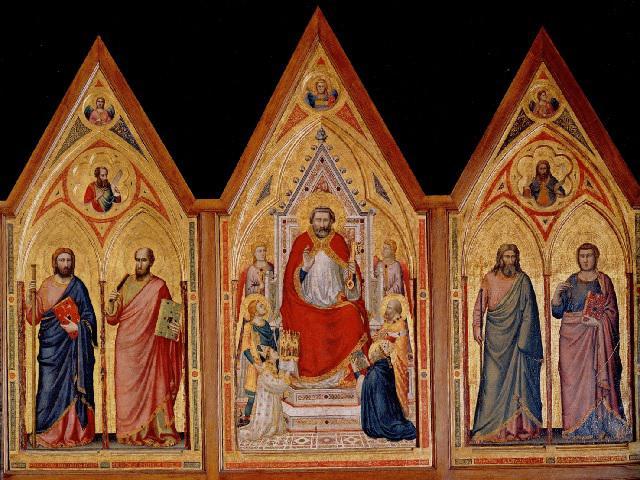Stefaneschi triptych

The Stefaneschi triptych, created by the renowned master Giotto in 1320, is a significant piece of art that holds both historical and religious importance. Commissioned by Cardinal Giacomo Gaetani Stefaneschi, this altarpiece was intended to adorn one of the altars in St. Peter's Basilica in Rome. The political symbolism behind the creation of this masterpiece is intriguing, as it was requested during a time when the papacy was situated in Avignon, France. The decoration of St. Peter's Basilica with the Stefaneschi triptych was part of an effort to bring the papacy back to Rome, showcasing the power and influence of the church during that period.
One of the most striking features of the Stefaneschi triptych is the representation of Cardinal Stefaneschi himself, depicted in a prayerful pose on both sides of the altarpiece in the central part. This unique aspect adds a personal touch to the artwork, emphasizing the connection between the patron and the religious themes depicted in the triptych. Another noteworthy characteristic of this piece is the fact that it is painted on both sides, allowing not only the faithful but also the priests to admire its beauty and symbolism. The scenes chosen for the triptych primarily focus on the apostles Peter and Paul, highlighting their importance in Christian iconography.
The altarpiece is divided into two main sections: the recto and the verso. On the recto side, Christ is depicted in the center on a throne, surrounded by angels, while the side panels showcase various biblical episodes from the New Testament, including images of martyrs and saints. On the verso side, Saint Peter is portrayed on a throne surrounded by angels and two speakers, with the side panels displaying standing saints along with their attributes. This arrangement follows the traditional polyptych format, with the central figures of sanctification and the cardinal positioned in the center faces of the triptych.
One intriguing aspect of the Stefaneschi triptych is the depiction of Cardinal Stefaneschi holding the painting, suggesting that it originally had a more elaborate frame. This detail adds a layer of complexity to the artwork, hinting at the artistic choices made by Giotto to enhance the overall composition. Additionally, the inclusion of a smaller version of the triptych within the painting itself is considered one of the earliest examples of the "Droste effect" in Renaissance art, showcasing Giotto's innovative approach to composition and visual storytelling. Overall, the Stefaneschi triptych stands as a testament to Giotto's skill as a master artist and the enduring legacy of his work in the realm of religious art.
© ChatGPT 3.5
*This is a rare example in Giotto's work of a commission that was documented and included the artist's signature. Many scholars feel that Giotto's workshop was responsible for the execution of this work.
*Its creation date is disputed, like most of Giotto's dates.
*The altarpiece is painted on both sides so that it can be seen by the congregation from the front and by the canons of the church from the back.
*The first location that this work had was on the altar of the Canons, in the old Saint Peter's Basilica, it is worth mentioning that this occurred at a time when the Pope's residence was located in Avignon. With this work Stefaneschi demanded the return of the papacy to the cradle of Christianity, to Rome.